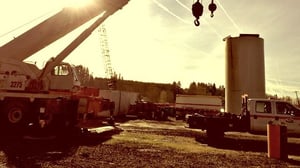When overloads and shock loads occur in a rigging operation, the results can be deadly. A failure of gear or equipment can take place at the time the over/shock load happens or in many cases weeks, months or years later.
Most of us are familiar with the statistics used in rigging books and charts on the affects of shock loading. When a load of “X” pounds is allowed to free-fall or is popped off the ground, it introduces a load to the lifting device which can be two times or more its static weight. This compounding of weight takes its toll on the load’s internal and external structure, rigging attachment points, all rigging hardware, slings, hoist hook, running ropes, drum and entire hoisting system whether overhead or mobile crane.
A typical method of shock loading results from turning or flopping a load over from one plane to another. (Actual case) A coal-fired steam plant uses pulverizer journal assemblies to crush the coal into a fine talc - like powder for burning. The journals are awkward and difficult to handle with no available lifting lugs. After a journal is pulled from service and it has received maintenance, it is transported back to the pulverizer unit. A bridge crane picks up the journal from its vertical carrying cradle and sets the base on the floor. The crane then trolleys to pull or “flop” the journal over to a 45 degree angle. A special sling assembly is then used to hoist the journal into the pulverizer cavity.
During the “trolley and flop” movement, the slamming of the journal arms into their chain slings sends dust and dirt flying off the overhead bridge crane. How much weight in real pounds was introduced to the crane? Has anything happened to the crane’s structure? Does anyone suspect a broken weld, metal fatigue fracture or that damage has possibly occurred to the hoist system or wire rope? What if this happens twice a month for four years? Your imagination can provide many unwelcome answers to these questions.
Have you ever heard an employee say, “We were only lifting 2 tons on our 5 ton bridge crane and the whole thing came down on top of us!” Was it the 2 ton lift that caused the accident? Certainly not! It was the four years of repeated abuse, shock loading and structural damage which turned a fine bridge crane into a life threatening bucket of bolts.
The final twist to this subject is that often a person not involved in creating the equipment’s damage is often the one injured or killed when the thing falls apart.
If you have these situations in your operation, do everything possible to develop alternative rigging methods. Make a comprehensive inspection of all hoisting and rigging components. Using the proper procedures for each type of equipment perform load tests and make another inspection to ensure reliability. (Always check with the equipment manufacturer for testing procedures and limitations.)
Ready to take your skills to the next level? Check out ITI's Crane Training course options today.
Happy Rigging, Mike Parnell.
This is an article from The Professional Rigger newsletter, 1988.




COMMENTS